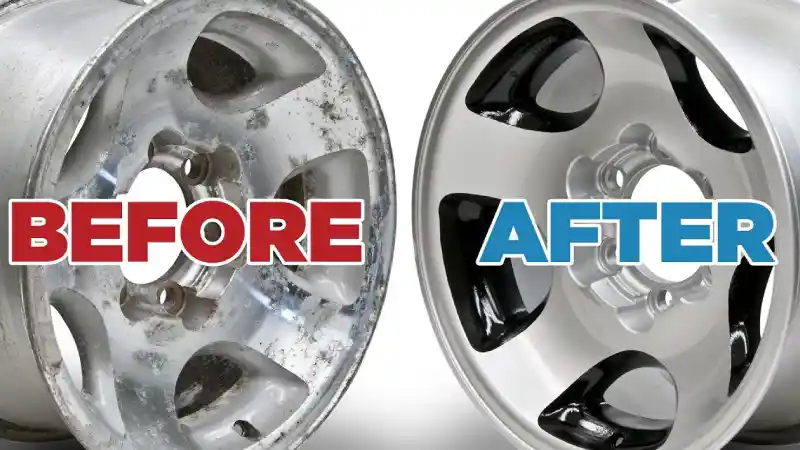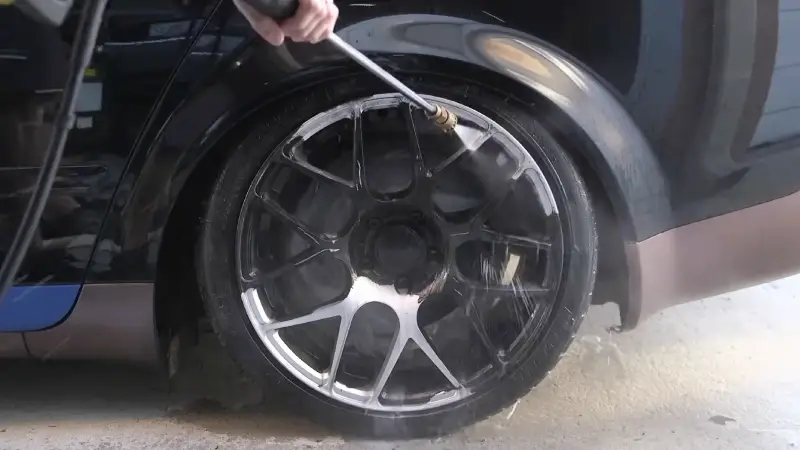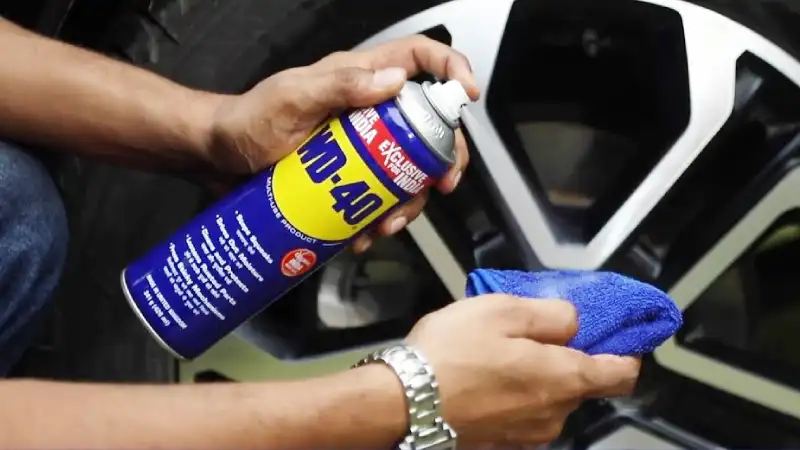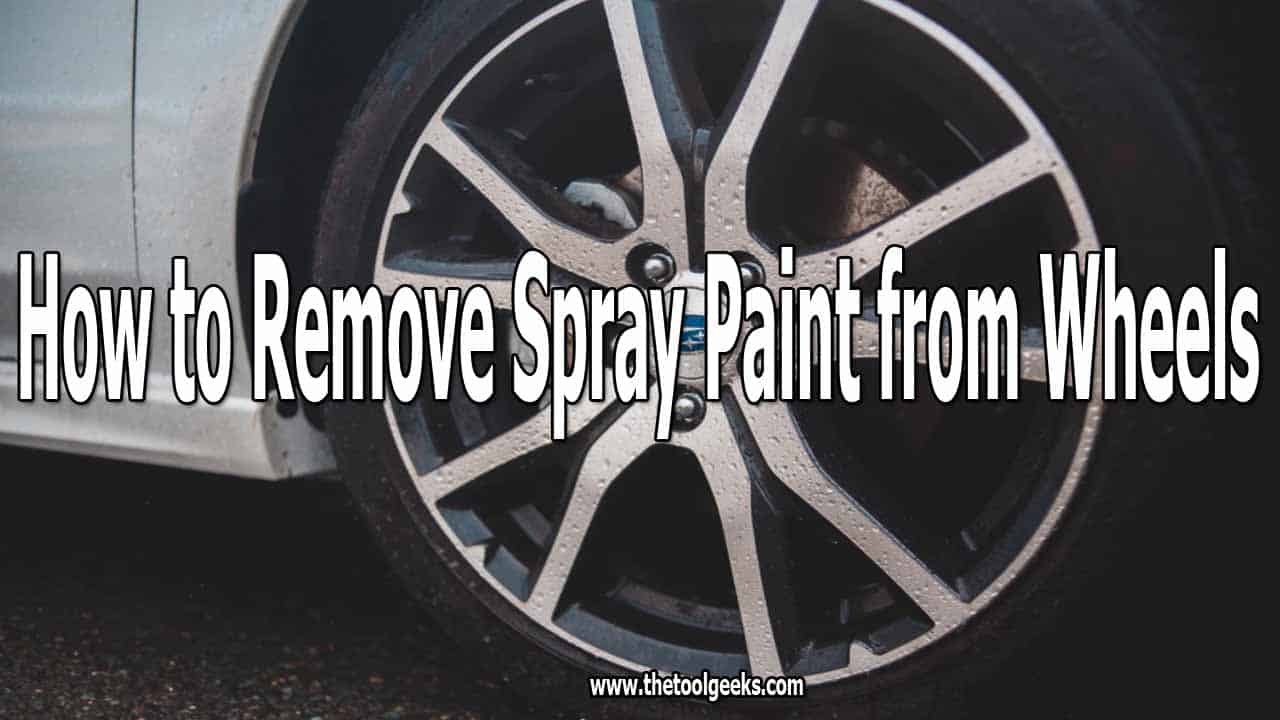How to Remove Spray Paint from Wheels | 7 DIY Steps
TheToolGeeks.com is a participant in the Amazon Services LLC Associates Program and other affiliate advertising programs. We may earn from qualifying purchases. (Learn More).
Spray painting wheels is a fun way to customize your vehicle’s look, but sometimes, you may want to revert to the original finish or try a new color. Removing spray paint from wheels, whether alloy or aluminum, requires careful consideration and the proper techniques to avoid damaging the wheels’ surface.
To start the cleanup, you’ll need a few supplies, like a quality paint remover and protective gloves. Be sure to test any chemical on a small, inconspicuous area of the wheel to ensure it doesn’t damage the finish.
But here’s the kicker: not all paint removers work the same on every type of wheel, and the wrong choice might leave you with more than unwanted paint. So, what’s the secret to picking the right one and using it effectively?
In this comprehensive guide, we will discuss seven DIY steps for removing spray paint from wheels, covering various methods and precautions to ensure a successful outcome. So, let’s explore.
Jump To Page Contents:
Seven DIY Steps to Remove Spray Paint from Wheels

To effectively get rid of spray paint from your wheels, you must gather specific tools and materials first and then follow these steps:
- Preparation and safety measures
- Remove the wheels
- Cleaning the wheels
- Selecting the paint removal method
- Applying the chosen paint removal method
- Gently remove the loosened paint
- Polishing and final cleaning
Tools and Materials Needed for this Job
Gathering the right tools and materials is crucial when removing spray paint from wheels. You’ll need:
- Strong chemical paint stripper suitable for wheels
- Protective gloves and goggles for safety
- Plastic wrap for covering and sealing the tire
- Wooden scraper or natural bristle brush for gentle removal
- Wire brush on a drill or angle grinder for tougher paint removal
- Chrome polish for restoring shine
- Clay bar and soapy water for meticulous cleaning
- Microfiber cloth for polishing the surface
Step 1: Preparation and Safety Measures
Before removing spray paint from your wheels, ensure you’re equipped with gloves and eye protection and that your workspace is well-ventilated. Safety is paramount when dealing with potentially hazardous materials.
Besides donning protective gear, confirm that your workspace is free from any sources of ignition, as some paint removers are highly flammable. Ensure that all necessary tools and materials are at hand before you start.
Step 2: Remove the Wheels
After ensuring your vehicle is parked on a stable, flat surface, use a jack to lift it and then secure it with jack stands before removing the wheels. Follow this procedure to safely access and clean the wheels without damaging your vehicle or yourself.
Once the car is securely raised, locate the lug nuts on each wheel. Using a lug wrench, turn the nuts counterclockwise to loosen them. You may need to apply significant force, so ensure you’re positioned to do so safely.
After loosening, remove the lug nuts and carefully remove each wheel, setting them aside in a safe, flat area to avoid any rolling or damage.
Step 3: Cleaning the Wheels
Once you’ve removed the wheels, thoroughly clean them with mild detergent and water to ensure the surface is free of dirt and grime. Use a soft brush or sponge to scrub the surface gently. This is crucial as any remaining particles can hinder the effectiveness of the paint removal process later on.
Rinse the wheels thoroughly with clean spray water to remove any soap residue. Check the wheels for any missed spots and clean again if necessary. Letting the wheels dry completely is vital before moving on to the next step.
Step 4: Selecting the Paint Removal Method
To effectively remove spray paint from your wheels, pick a paint removal method for the paint and your wheels’ condition. If you’re dealing with a light spray or overspray, rubbing alcohol or WD-40 might suffice. For tougher or multiple layers of paint, acetone or paint thinner could be more effective.
Assess the durability and finish of your wheels. If they’re chrome, consider a gentler approach, like chrome polish, to avoid damage. Always weigh your comfort and safety when handling chemicals. Choose a method that cleans effectively and preserves the integrity and aesthetics of your wheels.
Step 5: Applying the Chosen Paint Removal Method
Begin by applying your chosen solvent, such as acetone or rubbing alcohol, directly onto the spray-painted areas of your wheels. Following the product-specific instructions closely is crucial to ensure practical and safe application.
Typically, you’ll need to use a clean cloth or a brush to apply the solvent evenly across the painted surfaces. Wear protective gloves and work in a well-ventilated area to avoid inhaling fumes.
After applying the solvent, allow it to sit on the paint for the recommended time specified on the product label. This waiting period is essential as it lets the solvent penetrate and soften the paint, preparing it for subsequent removal. Avoid rushing this step to achieve the best results.
Step 6: Gently Remove the Loosened Paint
After the paint has softened, gently wipe away the loosened layers using a soft cloth or scrubber, ensuring it does not damage the wheel’s surface.
Use a light touch as you proceed, mainly if you’re working with chrome or polished wheels. Excessive pressure can lead to scratches that are difficult to repair. If you encounter stubborn paint spots, consider using a plastic scraper.
However, be careful not to gouge the wheel’s finish. Work slowly and methodically, frequently rinsing or changing your clothes to avoid spreading the paint remnants. This meticulous approach ensures that you remove all traces of spray paint while preserving the integrity and appearance of your wheels.
Step 7: Polishing and Final Cleaning
Once you’ve removed the spray paint, start polishing the wheels’ chrome surface to regain their shine and luster. Apply a high-quality chrome polish using a clean, soft cloth.
Rub the polish into the chrome circularly, ensuring even coverage and pressure to enhance the shine. This restores the aesthetic appeal and adds a layer of protection to the chrome against future tarnishing.
After polishing, clean the wheels. Rinse them thoroughly with warm water to remove any leftover residues from the paint removal and polishing processes. This ensures that your wheels aren’t only clean and shining like new.
Consideration While Removing Spray Paint from Car Wheels

Before removing spray paint from your car wheels, consider the following factors that impact the process’s effectiveness and safety.
1. Type of Wheels
Determining whether your car wheels are made of alloy or aluminum will influence how you remove spray paint without causing damage. Alloy wheels, typically composed of a mixture of metals, including aluminum, are generally more robust but can still suffer from abrasive techniques.
Pure aluminum wheels, however, are softer and more susceptible to scratching and pitting. You’ll need to assess the specific type of wheel to select the safest and most effective cleaning solution and technique.
2. Paint Thickness
After identifying your wheel type, consider the thickness of the spray paint, as this will impact the removal process. Thicker layers of paint often require more scrubbing and might need stronger solvents to break down effectively.
On the other hand, depending on the paint type and wheel material, a thinner coat may come off with less aggressive methods, such as a mild paint remover and water.
3. Surface Condition
You should assess the surface condition of your wheels to identify any existing scratches or damages before starting the spray paint removal process. Understanding the extent of these imperfections is crucial, as they can impact both the approach and the efficiency of the paint removal techniques you choose.
If your wheels display significant damage, you might need extra precautions to avoid worsening these areas. Moreover, identifying such issues beforehand allows you to integrate repair steps with the paint removal, ensuring a smoother finish and better overall restoration quality.
4. Testing Area
Once you’ve inspected your wheels for any pre-existing damage, testing your selected paint removal method on a less visible section will ensure it doesn’t cause further harm. Choose a small, discreet area on the wheel and apply the paint remover according to the product instructions.
5. Protection
Always wear appropriate gloves and safety gear when removing spray paint from car wheels to protect against harmful chemicals. Select gloves that resist solvents, shielding your skin from irritation and potential burns. Besides gloves, wear long sleeves and eye protection to guard against splashes and fumes.
Ensure your working area is well-ventilated. Open garage doors or work outside. Adequate airflow helps disperse toxic fumes, reducing your risk of inhaling dangerous chemicals. If ventilation is limited, consider using a respirator designed for paint fumes to safeguard your respiratory health.
6. Professional Assistance
If you need help safely removing spray paint from your car wheels, consult a professional or visit a specialty shop for expert guidance.
Professionals have the right tools and chemicals that are safe for your specific wheel type, whether alloy, steel, or chrome. They’ll also ensure the removal process doesn’t damage your wheels’ underlying surface or finish.
Moreover, specialists can provide tips on preventing future spray paint mishaps and maintaining the aesthetics of your wheels. Investing in professional services saves you time and guarantees that the job is done correctly and efficiently, preserving the value and appearance of your vehicle.
Does WD-40 remove spray paint from car wheels?

WD-40 can effectively remove some types of cheap spray paint from car wheels by acting as a solvent. This standard household product disintegrates the bonds in the spray paint, making scrubbing easier. It’s a practical solution for dealing with a minor paint issue or accidental overspray on your wheels.
To use WD-40, you’ll want to ensure the spray paint is completely dry. Shake the can well before applying a generous amount directly onto the painted areas of your wheels. Let it sit for about five to ten minutes. This waiting period allows the WD-40 to penetrate and soften the paint, enhancing its effectiveness.
What is the best paint remover for alloy wheels?
While WD-40 is a handy choice for minor paint removal, Peel Tec from C-Tec stands out as the best paint remover for alloy wheels.
Peel Tec’s formula is specifically designed to tackle the toughest spray paint without damaging the underlying surface of your alloy wheels. It’s a powerful solution that rapidly lifts paint, ensuring you’re not spending unnecessary time scrubbing and risking damage to your wheels.
Peel Tec is adequate and safe, making it ideal for first-time users. Unlike other harsh chemical removers that can emit harmful fumes and degrade the quality of your wheels, Peel Tec is formulated to be gentle on surfaces yet tough on paint.
Its application is straightforward: simply spray it onto the affected area, let it sit for a few minutes, and watch as the paint bubbles up, ready to be wiped away.
What is the cost-effective method for removing spray paint from wheels?
Although sandblasting and powder coating can be cost-effective for long-term durability, hand sanding, masking, and spray painting are more budget-friendly options for removing spray paint from wheels. When considering cost, weighing the materials needed and the time you’ll invest in the process is essential.
How can I preserve the factory finish while removing spray paint from the wheels?
To preserve the original finish on your wheels while removing spray paint, opt for gentle sanding techniques that minimize damage to the underlying surface.
Begin by selecting fine-grit sandpaper or a sanding sponge. These will allow you to delicately rub the unwanted paint without being too abrasive on the factory coating. Sand lightly and evenly, constantly checking to ensure you’re not penetrating the base paint or metal.
Once lightly sanded the spray paint, clean the area with a soft cloth dampened with water to remove dust or debris. This step is crucial as it prevents the fine particles from scratching the surface during the subsequent cleaning stages.
What do professionals use to clean alloy wheels after removing the spray paint?
Professionals often choose non-acidic cleaners like SONAX Wheel Cleaner, Wolfgang Tire & Wheel Cleaner, and P21S Wheel Cleaners to clean alloy wheels effectively after spray paint removal. Both clear-coated and polished alloy wheels can be cleaned with these products without damaging the underlying surface.
When you’re ready to clean your wheels, ensure you’ve thoroughly rinsed off any remnants of paint stripper or loose spray paint. This will prevent gritty particles from scratching the wheel surface during cleaning.
Achieving a Spotless Finish with the Right Spray Paint Removal Techniques
Removing spray paint from your wheels is like peeling back the layers of an onion. By following those seven steps for cleaning spray paint from alloy and aluminum wheels, you can restore their original appearance or prepare them for a new finish.
Always remember to exercise caution when working with chemicals and abrasive tools to avoid damaging the wheels. Also, ensure you opt for a method that preserves the wheels’ integrity and achieves a cost-effective, thorough clean.
Whether you choose to repaint the car wheels, powder coat, or leave the wheels bare, proper paint removal techniques are essential for achieving professional results. Experiment with different methods and products to find the best approach for your wheel restoration needs.
However, consider professional products for a spotless finish, akin to restoring the shine of a polished gem. With patience and attention to detail, your wheels will look as good as new after the paint removal process.
Amazon and the Amazon logo are trademarks of Amazon.com, Inc, or its affiliates.

